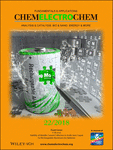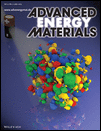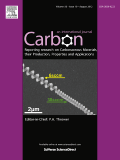
Carbon Trends
Scope & Guideline
Connecting Discoveries in Chemistry and Materials Science
Introduction
Aims and Scopes
- Synthesis and Characterization of Carbon Materials:
This area emphasizes the development of novel methods for synthesizing carbon materials such as graphene, carbon nanotubes, and activated carbons, along with detailed characterization techniques to understand their structural and functional properties. - Energy Storage and Conversion:
Research within this scope includes the exploration of carbon materials in energy storage systems like supercapacitors and batteries, as well as their roles in energy conversion processes, such as catalysis for fuel cells and photocatalysis for CO2 reduction. - Environmental Applications:
This theme covers the utilization of carbon materials for environmental remediation, including the adsorption of pollutants, water treatment, and the development of eco-friendly materials from waste biomass. - Advanced Composite Materials:
The journal highlights studies on carbon-based composites, focusing on their mechanical, thermal, and electrical properties, and their potential applications in various industrial sectors. - Nanotechnology and Nanomaterials:
This area investigates the properties and applications of carbon nanomaterials, including their use in sensors, drug delivery systems, and as components in nanodevices. - Theoretical and Computational Studies:
Research involving computational modeling and simulation to predict the behavior of carbon materials under various conditions, enhancing the understanding of their properties and guiding experimental efforts.
Trending and Emerging
- Sustainable and Green Chemistry:
There is a growing focus on sustainable practices in carbon material synthesis, including the valorization of waste biomass and green synthesis methods, reflecting a broader trend towards environmental responsibility in research. - Advanced Energy Storage Solutions:
With the increasing demand for efficient energy storage technologies, research on carbon materials for next-generation batteries, supercapacitors, and hybrid systems is on the rise, focusing on enhancing performance and sustainability. - Carbon-Based Nanocomposites:
The integration of carbon materials with other nanomaterials to form composites is trending, particularly in applications for electronics, sensors, and energy devices, showcasing the versatility and multifunctionality of carbon. - Machine Learning and Data Science Applications:
The application of machine learning techniques to predict material behaviors and optimize synthesis processes is emerging as a significant trend, enabling more efficient research and development in carbon materials. - Electrocatalysis and CO2 Reduction Technologies:
Research on carbon materials as electrocatalysts for CO2 reduction and other energy conversion reactions is increasingly prominent, reflecting the urgency of addressing climate change through innovative carbon technologies.
Declining or Waning
- Traditional Carbon Materials:
There is a noticeable shift away from studies focusing solely on conventional carbon materials like carbon black and standard activated carbon, as researchers increasingly explore more advanced and functionalized carbon nanomaterials. - Basic Characterization Techniques:
While fundamental characterization remains important, there is a decreasing emphasis on basic methods, with a preference for more sophisticated techniques that provide deeper insights into the properties of carbon materials. - Single-Use Applications:
Research focusing on single-use or low-performance applications of carbon materials is declining, as the emphasis shifts towards multifunctional and sustainable applications that leverage the advanced properties of carbon nanomaterials.
Similar Journals

ChemElectroChem
Advancing the frontiers of catalysis and electrochemistry.ChemElectroChem is a premier open-access journal published by WILEY-V C H VERLAG GMBH, focusing on the interdisciplinary fields of catalysis and electrochemistry. Established in 2014 and actively publishing until 2024, this journal boasts an impressive reputation, currently ranked in the Q2 category for both catalysis and electrochemistry according to the 2023 metrics. With an Scopus ranking placing it in the 74th percentile for Electrochemistry and 61st for Chemical Engineering and Catalysis, ChemElectroChem serves as an essential platform for researchers, professionals, and students dedicated to advancing knowledge and fostering innovation in these critical scientific domains. Since its transition to open access in 2023, the journal aims to maximize the dissemination of cutting-edge research and facilitate the exchange of ideas among global scholars, thereby enhancing the accessibility and impact of high-quality science within the community. For those engaged in the ever-evolving conversations around energy storage, conversion processes, and sustainable solutions, ChemElectroChem is an invaluable resource.

Advanced Energy Materials
Exploring Breakthroughs in Energy Materials ScienceAdvanced Energy Materials is a leading academic journal published by WILEY-V C H VERLAG GMBH, focusing on the rapidly evolving fields of materials science and renewable energy technologies. With an impressive impact factor and recognition as a top-tier journal, it ranks within the Q1 category in both Materials Science (miscellaneous) and Renewable Energy, Sustainability and the Environment as of 2023. Spanning from 2011 to 2024, the journal serves as an essential platform for researchers, professionals, and students eager to explore groundbreaking advancements in energy materials, fostering innovative solutions to global sustainability challenges. The journal's authoritative content is supported by rigorous peer review, ensuring high-quality research contributes to the academic community and beyond. Located in Weinheim, Germany, Advanced Energy Materials stands at the forefront of scientific inquiry, making it an invaluable resource for those invested in the future of energy and materials science.

Polymer-Plastics Technology and Materials
Redefining the Landscape of Polymer EngineeringPolymer-Plastics Technology and Materials is a premier academic journal published by Taylor & Francis Inc., dedicated to the dynamic fields of chemical engineering, materials chemistry, and polymers and plastics. With an impact factor that reinforces its reputation, this journal is strategically indexed in Scopus, ranked notably within its categories (Q2), showcasing its influence and relevance in the academic community. Since its inception in 2019, the journal has served as an essential platform for researchers, professionals, and students to disseminate innovative studies and advancements in polymer science and materials technology. As an Open Access publication, it ensures that cutting-edge research is accessible to a global audience, fostering collaboration and knowledge sharing in the material sciences. Located in the United Kingdom, Polymer-Plastics Technology and Materials continues to enhance the dialogue within the industry, addressing critical challenges and exploring emerging trends that shape the future of polymer and plastics technologies.

Boletin del grupo espanol del carbon
Catalyzing Collaboration in Carbon ScienceBoletin del Grupo Español del Carbon, a pivotal journal in the field of carbon science, is published by the Grupo Español Carbon and serves as a significant platform for disseminating research related to carbon materials, their applications, and advancements in carbon technology. With an ISSN of 2172-6094, this journal aims to bridge the gap between academia and industry by featuring original research articles, reviews, and noteworthy contributions from specialists in the sector. Though currently not designated as Open Access, the journal's commitment to quality ensures that the articles are available through various academic databases, enhancing accessibility for researchers, professionals, and students alike. Located in Zaragoza, Spain, at the prestigious Instituto Carboquímica, the journal endorses rigorous peer review and strives to foster international collaboration within the carbon research community. By maintaining high academic standards, Boletin del Grupo Español del Carbon aspires to impact the fields of materials science and environmental sustainability significantly.

FULLERENES NANOTUBES AND CARBON NANOSTRUCTURES
Innovating the Future with Carbon-Based ResearchFULLERENES NANOTUBES AND CARBON NANOSTRUCTURES, published by Taylor & Francis Inc, stands at the forefront of research in the fields of nanotechnology, materials science, and organic chemistry. With an ISSN of 1536-383X and an E-ISSN of 1536-4046, this journal offers a critical platform for disseminating significant findings related to carbon-based nanostructures, materials characterization, and their innovative applications. Recognized for its scholarly impact, the journal enjoys a Q2 ranking in several fields, including Atomic and Molecular Physics, Materials Science, and Organic Chemistry, reflecting its commitment to quality research. Since its inception in 2002, it has maintained a rigorous publication standard and provides open access options, enabling a diverse audience, from researchers to industry professionals, to engage with the latest advancements. The journal's comprehensive scope across converged years until 2024 emphasizes its pivotal role in fostering knowledge in the rapidly evolving realm of nanoscience and nanotechnology. Researchers and practitioners alike are encouraged to explore the cutting-edge research showcased in this vital resource.

Nano Express
Exploring the cutting-edge of nanomaterials.Nano Express is an esteemed open-access journal published by IOP Publishing Ltd, dedicated to advancing research in the fields of nanotechnology and materials science. Since its launch in 2020, the journal has swiftly established itself as a vital resource for researchers and professionals, garnering significant recognition in various domains, including biomaterials, electronic, optical and magnetic materials, and polymers and plastics. With a commendable categorization in Scopus quartiles, it ranks in Q2 for Electronic, Optical and Magnetic Materials, and maintains a top percentile in several others, exemplifying its commitment to high-quality research dissemination. Located in the United Kingdom, this journal fosters a global dialogue among experts and newcomers alike, facilitating open access to innovative research that drives the future of nanotechnology. By offering a platform for groundbreaking studies and reviews, Nano Express aims to bridge the gap between theoretical understanding and practical application, championing the development of next-generation materials that have the potential to transform various industries.

CARBON
Elevating Knowledge in Carbon ApplicationsCARBON is a leading peer-reviewed journal published by PERGAMON-ELSEVIER SCIENCE LTD, focusing on the realms of Chemistry and Materials Science. With an impressive impact factor, CARBON is ranked within the top quartile (Q1) of both fields in the 2023 Scimago Journal Rank, remarkably securing the 18th position out of 463 in General Materials Science and the 22nd position out of 408 in General Chemistry. Since its inception in 1963, the journal has been dedicated to publishing high-quality research that advances the understanding of carbon-based materials and their applications. Operating from the United Kingdom, CARBON provides an essential platform for researchers, professionals, and students alike to disseminate their findings and innovations. Although not an open-access journal, it offers access options that maintain the integrity and high standards of academic publishing. As a critical resource in its field, CARBON continues to foster scientific dialogue and development, significantly impacting current and future research.

Energy Material Advances
Driving Progress in Fuel Technology and SustainabilityEnergy Material Advances, published by the American Association for the Advancement of Science, stands at the forefront of energy research, showcasing groundbreaking studies in the realm of renewable energy, fuel technology, and materials science. With the journal's commitment to open access since 2020, it aims to democratize knowledge and foster innovation across a global community of researchers, professionals, and students. The journal boasts an impressive impact factor, placing it firmly within the Q1 category across multiple disciplines including Energy (miscellaneous), Fuel Technology, and Renewable Energy, Sustainability and the Environment, highlighting its significance in advancing scholarly discussions. In the latest Scopus rankings, Energy Material Advances ranks among the top 10% of journals in its field, affirming its role as a pivotal resource for current and emerging trends in energy materials. The journal is dedicated to facilitating collaborative efforts and inspiring novel approaches to the challenges posed by energy sustainability and technological advancement.

JOURNAL OF CLUSTER SCIENCE
Advancing Knowledge in Interdisciplinary ResearchJOURNAL OF CLUSTER SCIENCE, published by SPRINGER/PLENUM PUBLISHERS, is a prominent and influential journal in the fields of Biochemistry, Chemistry, Condensed Matter Physics, and Materials Science. With an ISSN of 1040-7278 and E-ISSN of 1572-8862, this journal has been contributing to scientific discourse since its inception in 1990 and continues to publish cutting-edge research through 2024. It holds a respectable position in the academic landscape with its category quartiles indicating a Q3 ranking in Biochemistry and Q2 rankings in Chemistry, Condensed Matter Physics, and Materials Science as of 2023. The journal's noteworthy Scopus rankings further underscore its relevance, particularly a rank of #82 in Condensed Matter Physics, showcasing its impact and the quality of research disseminated. Although it does not currently offer open access options, it remains a key resource for researchers, professionals, and students who are invested in understanding the complexities of cluster science and its interdisciplinary applications.

NEW CARBON MATERIALS
Bridging Theory and Application in Carbon ResearchNEW CARBON MATERIALS, published by Elsevier, is a leading academic journal that focuses on the innovative and multidisciplinary field of carbon materials research. With an ISSN of 2097-1605 and an E-ISSN of 1872-5805, this journal has established itself as a prominent platform for disseminating cutting-edge studies and applications in the realm of carbon nanomaterials, composites, and their industrial applications. Recognized for its high quality, NEW CARBON MATERIALS holds a Q1 ranking in the Materials Science category, reflecting its significant impact within the scientific community. The journal has continuously fostered knowledge exchange since its inception in 2004 and is set to further advance research until 2024. With a Scopus rank of #89 out of 463 journals in the General Materials Science category, this publication is essential for researchers, professionals, and students seeking to stay informed about the latest developments in carbon materials. While it is not an open-access journal, it offers various access options to ensure that the latest findings are available to a broad audience. By bridging the gap between theory and practical application, NEW CARBON MATERIALS is at the forefront of addressing critical challenges and paving the way for future advancements in materials science.